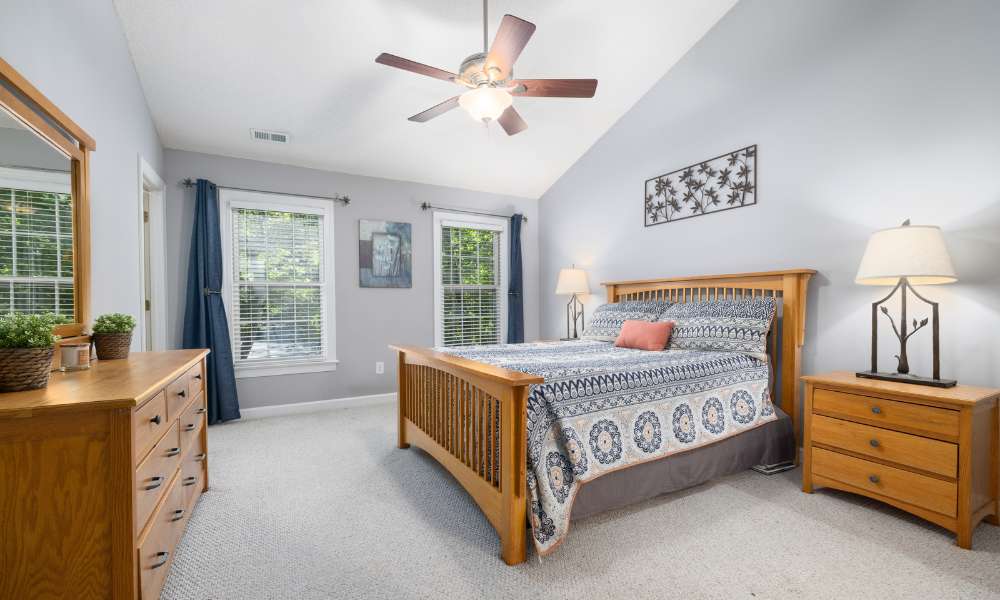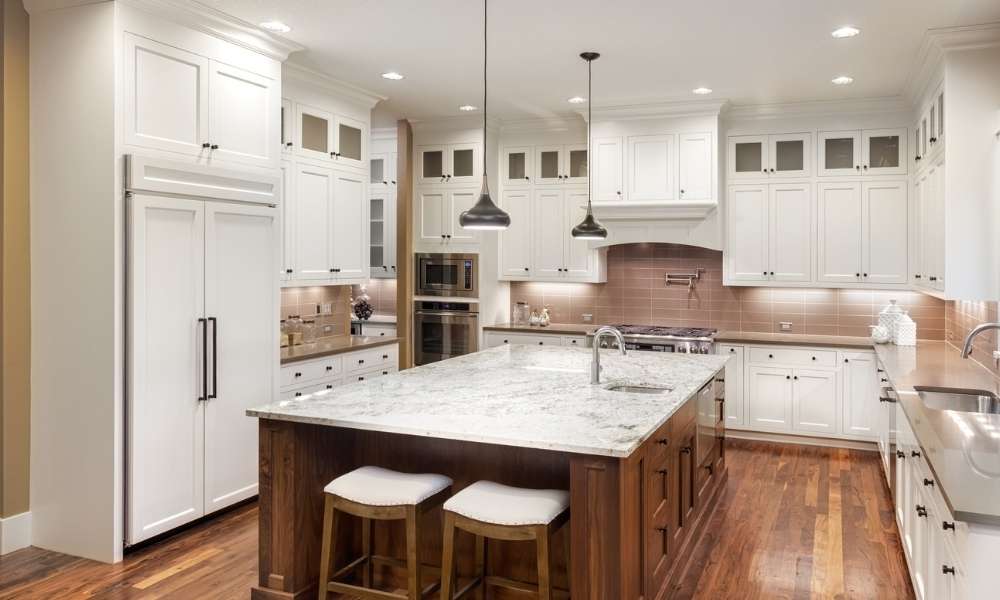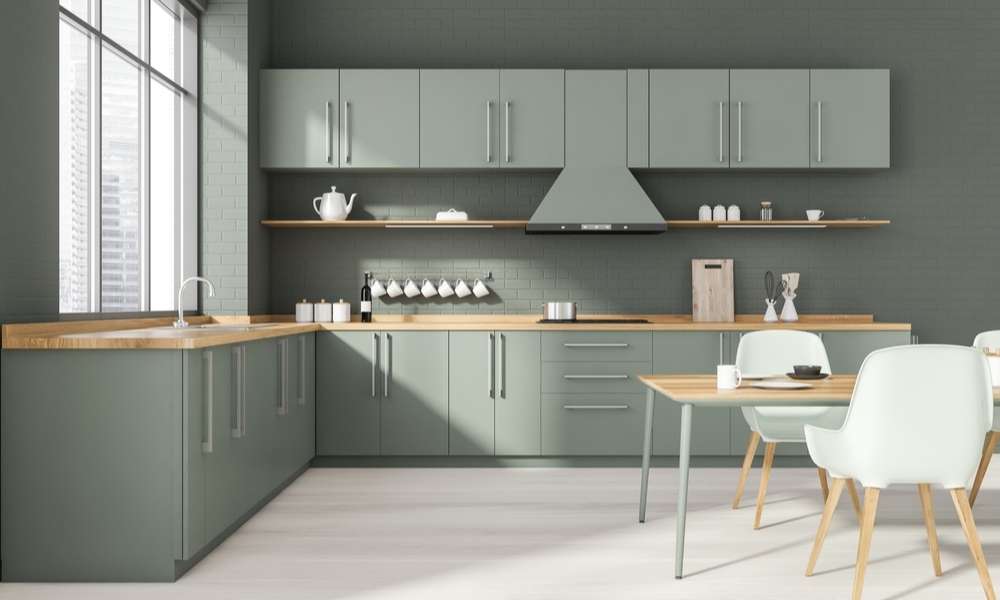Arranging bedroom furniture might seem like a daunting task, but it’s a game-changer for both the aesthetics and functionality of your space. Knowing how to arrange bedroom furniture can significantly enhance the comfort and appeal of your room, making it a peaceful retreat where you can unwind and recharge. In this guide, we’ll delve into the benefits of thoughtful furniture placement, highlight what’s important to consider, and provide practical tips to make the most out of your bedroom setup. Whether you’re revamping your current layout or starting from scratch, understanding how to arrange bedroom furniture effectively can transform your bedroom into an organized, stylish, and inviting space.
What Is The Best Layout For A Small Bedroom?
An effective layout strategy for small bedrooms is to use vertical space wisely. Consider installing floating shelves or wall-mounted storage units to free up floor space and provide additional storage options. Additionally, using light colors for walls and furniture can help make the room feel larger and more airy. Overall, the best layout for a small bedroom is one that balances practicality with aesthetics, creating a cozy and functional space within limited square footage.
Should I Place My Bed Against The Wall Or In The Center Of The Room?
The placement of your bed in a room depends on various factors such as the size and layout of the room, your personal preferences, and the overall aesthetic you are trying to achieve. Placing your bed against the wall can create a cozy and intimate feel, especially if you have limited space or want to maximize floor space for other furniture. It can also provide a sense of security and support if you prefer having a solid surface behind you while sleeping.
Identifying Architectural Features
One approach to identifying architectural features is to consider the historical context of the building. Research the time period when the structure was built and look for signature architectural styles that were popular during that era. By understanding the history of the architecture, you can better appreciate and emphasize its unique features in your design scheme. Ultimately, paying close attention to these architectural details can help you create a cohesive and harmonious space that celebrates its inherent beauty and character.
Considering Natural Light Sources
Understanding and utilizing natural light sources is another crucial aspect of arranging bedroom furniture. The placement of your bed, desk, or reading nook in relation to windows can drastically affect the ambiance and functionality of your room. Ideally, you want to position your bed so that you wake up with natural light, but without it shining directly in your eyes. Similarly, arranging a workspace near a source of natural light can boost your mood and productivity. Proper alignment with natural light can enhance your bedroom’s warmth and welcoming feel, making it a more enjoyable space.
Establishing A Style Or Theme
Deciding on a style or theme before you start to arrange bedroom furniture can provide direction for your layout and choices. Whether you’re drawn to minimalist designs, a bohemian vibe, or a more traditional look, your preferred style will influence the type of furniture you select and how you place it. This coherence not only makes your bedroom more visually appealing but also ensures that it reflects your personal taste and becomes a space where you feel truly at home.
Sketching A Layout
Sketching a layout for arranging bedroom furniture can be a fun and creative process that allows you to visualize different configurations before physically moving anything. Start by measuring the dimensions of the room and piece of furniture to accurately represent them in your sketch. Consider the focal point of the room, such as a bed or a large window, and arrange your furniture around it to create balance and harmony.
Creating A Floor Plan
Creating a floor plan is the next crucial step in arranging bedroom furniture. With a detailed floor plan, you can scale your furniture to the room’s dimensions, preventing overcrowding or underutilization of space. This plan serves as a blueprint, guiding you on where each furniture piece should go and how it interacts with the room’s overall flow. By creating a floor plan, you can identify the best layout that promotes ease of movement and accessibility, enhancing the room’s comfort and appeal.
Allocating Space For Each Furniture Piece
Allocating space for each furniture piece is essential to prevent a cluttered or imbalanced room. Every item, from your bed to the nightstand, needs a designated spot that contributes to the room’s functionality and aesthetics. Allocating space thoughtfully ensures that each furniture piece is both accessible and in harmony with the room’s layout. This strategic placement can significantly impact the room’s feel, making it more spacious, organized, and inviting.
Determining The Best Wall For The Bed
Determining the best wall for the bed is often the focal point to arrange bedroom furniture. The bed’s placement can influence the room’s layout and ambiance. Ideally, the bed should be positioned against a solid wall, away from the doorway, to create a sense of privacy and stability. The right wall for the bed enhances the room’s flow, maximizes space, and contributes to a restful environment. By carefully selecting the bed’s location, you can create a focal point that anchors the room and defines its overall layout.
Ensuring Proper Bed Alignment
Proper bed alignment not only contributes to the room’s aesthetics but also affects your comfort and well-being. The bed should be positioned to allow for a symmetrical arrangement of nightstands and lamps, creating a balanced and cohesive look. Ensure there’s equal space on either side of the bed for accessibility and maintain a clear path to the door. The bed’s alignment can also influence the room’s energy and flow, so consider principles of Feng Shui or similar philosophies if they resonate with you.n
Choosing Suitable Bedside Tables
Choosing suitable bedside tables is crucial for both aesthetics and functionality. The right bedside table should complement your bed’s height and design, offering convenient storage and surface space for your essentials. It’s not just about style; the functionality of your bedside table affects your nightly routine, providing a spot for your book, glasses, or a comforting lamp. Ensure the tables are proportionate to your bed and room size to maintain balance and avoid a cluttered look.
Selecting Appropriate Lighting Fixtures
Lighting is another critical element in the arrangement of bedroom furniture. The right lighting fixtures can transform the ambiance of the room, making it cozy, inviting, and functional. Consider layering different types of lighting: ambient for overall illumination, task lighting for reading or other activities, and accent lights to highlight architectural features or artwork. Choosing dimmable options can also add versatility to your bedroom, allowing you to adjust the brightness according to the time of day or your mood.
Avoiding Overcrowding With Accessories
A common mistake people make is cluttering surfaces with too many items. To prevent this, try grouping accessories together in clusters rather than scattering them around haphazardly. By creating curated vignettes, you can showcase your favorite pieces while maintaining a cohesive look in the room. Remember, less is often more when it comes to accessorizing your space effectively.
Positioning Electronics For Convenience
Positioning electronics for convenience is also essential in modern bedrooms. Whether it’s a TV, a sound system, or charging stations, strategically placing these items can enhance your experience while maintaining the room’s aesthetic. Ensure cables are neatly managed and that electronics don’t dominate the space, preserving the bedroom’s primary function as a place for rest and rejuvenation.
Securing Heavy Furniture To The Wall
Safety is paramount in any bedroom arrangement, particularly when it comes to furniture . Securing items like dressers and bookcases to the wall can prevent tipping accidents, making your bedroom a safer space for everyone. This step is especially important in children’s rooms or if you live in an area prone to earthquakes. By taking this precaution, you ensure that your bedroom is not only stylish and functional but also safe for all occupants.
The Final Thought
To arrange bedroom furniture is a crucial aspect of creating a comfortable and functional living space. By following the tips outlined in this article, you can maximize the use of your room while maintaining an aesthetically pleasing layout. Remember to consider the size and shape of your room, prioritize essential pieces such as the bed and storage units, and create designated areas for specific activities. With careful planning and attention to detail, you can transform your bedroom into a sanctuary that promotes relaxation and productivity. Take the time to assess your current furniture arrangement and make adjustments as needed to optimize both the look and functionality of your space.





